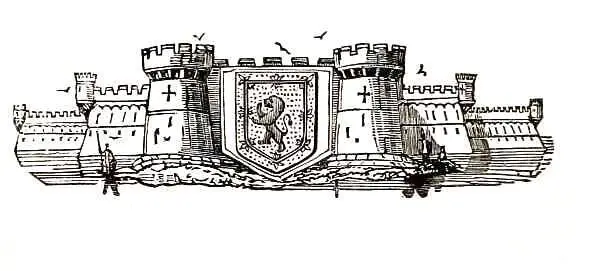James Burnes - Sketch of the History of the Knights Templars
Здесь есть возможность читать онлайн «James Burnes - Sketch of the History of the Knights Templars» — ознакомительный отрывок электронной книги совершенно бесплатно, а после прочтения отрывка купить полную версию. В некоторых случаях можно слушать аудио, скачать через торрент в формате fb2 и присутствует краткое содержание. Жанр: foreign_antique, foreign_prose, Историческая проза, на английском языке. Описание произведения, (предисловие) а так же отзывы посетителей доступны на портале библиотеки ЛибКат.
- Название:Sketch of the History of the Knights Templars
- Автор:
- Жанр:
- Год:неизвестен
- ISBN:нет данных
- Рейтинг книги:4 / 5. Голосов: 1
-
Избранное:Добавить в избранное
- Отзывы:
-
Ваша оценка:
- 80
- 1
- 2
- 3
- 4
- 5
Sketch of the History of the Knights Templars: краткое содержание, описание и аннотация
Предлагаем к чтению аннотацию, описание, краткое содержание или предисловие (зависит от того, что написал сам автор книги «Sketch of the History of the Knights Templars»). Если вы не нашли необходимую информацию о книге — напишите в комментариях, мы постараемся отыскать её.
Sketch of the History of the Knights Templars — читать онлайн ознакомительный отрывок
Ниже представлен текст книги, разбитый по страницам. Система сохранения места последней прочитанной страницы, позволяет с удобством читать онлайн бесплатно книгу «Sketch of the History of the Knights Templars», без необходимости каждый раз заново искать на чём Вы остановились. Поставьте закладку, и сможете в любой момент перейти на страницу, на которой закончили чтение.
Интервал:
Закладка:

THE TEMPLARS
"And on his brest a bloodie crosse he bore,
The deare remembrance of his dying Lord,
For whose sweete sake that glorious badge he wore,
And dead, as living, ever him ador'd;
Upon his shield the like was also scor'd,
For soveraine hope, which in his helpe he had.
Right, faithfull, true he was in deede and word:
But of his cheere did seeme too solemne sad;
Yet nothing did he dread, but ever was ydrad."
JACQUES DE MOLAY.
GRANDE MAITRE DE L'ORDRE DU TEMPLE.
CHAP. II.
The Knights Templars
It was in the year 1119, the twentieth of the Christian dominion in Syria, that nine pious and valiant Knights, the greater part of whom had been the companions of Godfrey de Bouillon, formed themselves into an association, the object of which was to protect and defend Pilgrims on their visits to the holy places. These Knights, of whom the two chief were Hugo de Payens and Godfrey de St. Omer, vowed, in honour of the sweet Mother of God , to unite Monkhood and Knighthood; 4 4 The other original associates of the Order were the Knights Roral, Gundemar, Godfrey Bisol, Payens de Montidier, Archibald de St. Aman, Andrew de Montbar, and the Count of Provence, according to the German historian, Wilcke.
their pious design met with the warm approbation of the King and the Patriarch, and in the hands of the latter they made the three ordinary vows of poverty, chastity, and obedience; and a fourth, of combating without ceasing against the heathen, in defence of Pilgrims and of the Holy Land; and bound themselves to live according to the rule of the canons of St. Augustine, at Jerusalem. The King assigned them for their abode a part of his palace, which stood close by where had stood the Temple of the Lord. He and his barons contributed to their support, and the abbot and canons of the Temple assigned them for the keeping of their arms and magazines the street between it and the royal palace, and hence they took the name of the soldiery of the Temple, or Templars. When Fulk, Count of Anjou, in the year following the formation of the society, made a pilgrimage to the Holy Land, the Order was even then in such repute that he joined it as a married brother, and on his return home remitted them annually thirty pounds of silver to aid them in their pious labours, and his example was followed by several other Christian princes.
For the first nine years after their institution, the Templars lived in poverty and humility, and no new members joined their society, which was eclipsed by that of St. John. Their clothing consisted of such garments as were bestowed on them by the charity of the faithful, and so rigorously were the gifts of pious princes applied by them to their destination – the benefit of pilgrims and of the Holy Land in general – that in consequence of their poverty, Hugo de Payens and Godfrey de St. Omer had but one war-horse between them. When the Order had arrived at wealth and splendour, its seal, representing two Knights mounted on one charger, commemorated this original poverty of its pious founders.
During the reign of Baldwin II. the kingdom was hard pressed by the Turks of Damascus, Mossul, and the neighbouring states, and the king had been a captive in their hands. On his liberation he sought every means of strengthening his kingdom, and as the Templars had displayed such eminent valour and devotion wherever they had been engaged, he resolved to gain them all the influence and consideration in his power. Accordingly he dispatched two of their members as his envoys to the Holy See, to lay before the Pope the state of the Holy Land, and also furnished them with a strong letter of recommendation to the celebrated Bernard of Clairvaux, the nephew of one of the envoys. Bernard approved highly of the object and institution of the Order. Hugo de Payens and five other brethren soon arrived in the west, and appeared before the fathers, who were assembled in council at Troyes, to whom Hugo detailed the maxims and the deeds of the Templars. The fathers expressed their approbation of all he said, the Order was pronounced good and useful, and same additions, taken from that of the Benedictines, were made to their rule. By the direction of Pope Honorius, the council appointed them a white mantle as their peculiar dress, to which Pope Eugenius some years afterwards added a red cross on the breast – the symbol of martyrdom. Their banner was of the black and white stripe, called, in old French, Bauseant (which word became their war-cry,) and bore the pious inscription, Non nobis, Domine, non nobis, sed nomini tua da gloriam . 5 5 Bauseant or Bausant , was, in old French, a pie-bald horse. The word is still preserved with its original meaning in the Scotch dialect, in the form Bawsent : — "His honest, sonsie, baws'nt face, Aye gat him freends in ilka place," says Burns, describing the "Ploughman's Collie" in his Tale of the "Twa Dogs;" and in the Glossary, Dr. Currie explains Bawsent as meaning "having a white stripe down the face." Some conceive that the word Beauseant may be merely an old variation of the modern French word Bienséant , as referring to something handsome or attractive.
St. Bernard, if he did not himself draw up the rule of Order, had at least a considerable participation in it; throughout his life he cherished the Templars; he rarely wrote a letter to the Holy Land, in which he did not praise them, and recommend them to the favour and protection of the great.
Owing to the influence of Bernard, and the sincere piety and noble qualities of its founders, the Order rapidly increased in wealth and consequence. Many Knights assumed its habit, and with Hugo de Payens travelled through France and England, to excite the Christians to the sacred war. With Henry I. of England they met the highest consideration. Fulk, of Anjou, re-united himself to Hugo de Payens, and on the invitation of King Baldwin, prepared, though advanced in years, to set out for Palestine, to espouse the daughter of the king, and succeed him on his throne. Gifts in abundance flowed in on the Order, large possessions were bestowed on it in all countries of the west, and Hugo de Payens, now its Grand Master, returned to the Holy Land in the year 1129, at the head of three hundred Knights Templars of the noblest families in Europe, ready to take the field against the Infidels.
The Templars soon became, in fact, the most distinguished of the Christian warriors. By a rule of their Order, no brother could be redeemed for a higher ransom than a girdle or a knife, or some such trifle; 6 6 Expediency afterwards prompted the infraction of this original rule. Gerard de Ridefort, Grand Master of the Order, was liberated by Saladin, along with several other captives, for no less a ransom than the city of Ascalon. In 1244 also, the Templars endeavoured to redeem their brethren from captivity in Egypt.
captivity was therefore equivalent to death, and they always fought with Spartan desperation. The Bauseant was always in the thick of the battle; the revenue they enjoyed enabled them to draw to their standard valiant secular knights and stout and hardy footmen. The chivalry of St. John vied with them, it is true, in prowess and valour, but they do not occupy the same space in the History of the Crusades. The Templars having been from the outset solely devoted to arms, – the warm interest which St. Bernard, whose influence was so great, took in their welfare, – and the circumstance that the fourth King of Jerusalem was a member of their body, – all combined to throw a splendour about them which the Knights of St. John could not claim, but which also gave occasion to their more speedy corruption, and augmented the number of their enemies. Most writers, however, of the twelfth century speak respectfully of the Knights of the Temple, and those unsparing satirists, the Troubadours, never mention them but with honour. The history of the Order, as far as we can recollect, records only one instance of a Templar abjuring his faith, and that was an English Knight, Robert of Saint Albans, who deserted to Saladin, who gave him his sister in marriage on his becoming a Moslem; and in 1185, the ex-red-cross Knight led a Saracen army to the neighbourhood of Jerusalem, wasting and destroying the country with fire and sword. 7 7 Mathew Paris charges a certain Templar, named Ferrandus, with having gone over to the Infidels, and betrayed the state of the Christian garrison in Damietta, A. D. 1221. This deserter was reputed to have been a knight " in armis strenuus et consilio circumspectus ."
Интервал:
Закладка:
Похожие книги на «Sketch of the History of the Knights Templars»
Представляем Вашему вниманию похожие книги на «Sketch of the History of the Knights Templars» списком для выбора. Мы отобрали схожую по названию и смыслу литературу в надежде предоставить читателям больше вариантов отыскать новые, интересные, ещё непрочитанные произведения.
Обсуждение, отзывы о книге «Sketch of the History of the Knights Templars» и просто собственные мнения читателей. Оставьте ваши комментарии, напишите, что Вы думаете о произведении, его смысле или главных героях. Укажите что конкретно понравилось, а что нет, и почему Вы так считаете.












